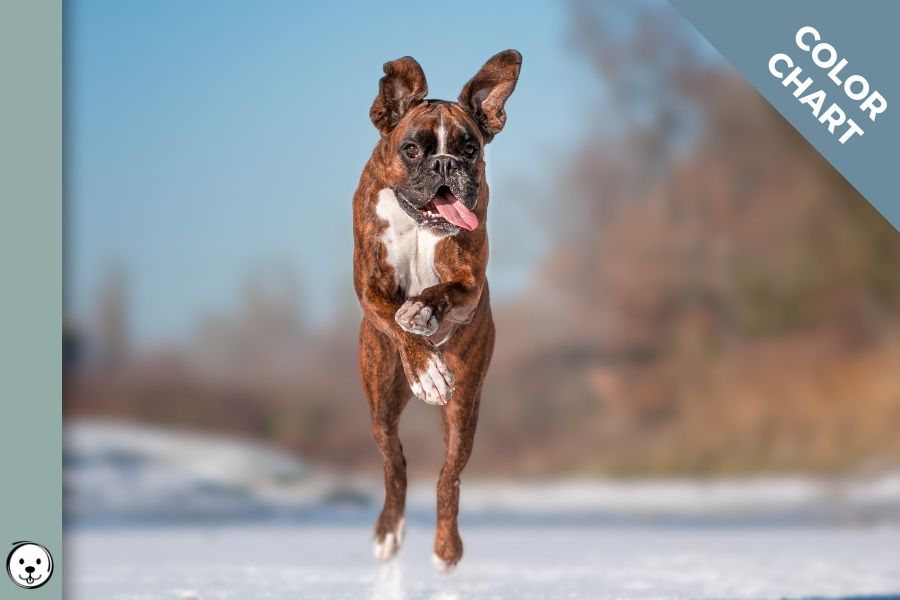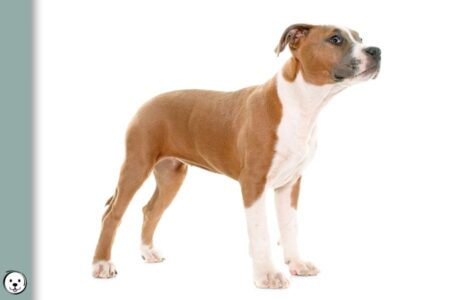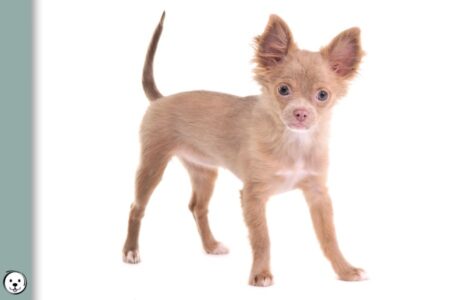An overview of Boxer colors and their genetics.
| Em/Em melanistic mask Ay/Ay sable | S/S solid | S/sP flashy | sP/sP white |
| ky/ky normal | 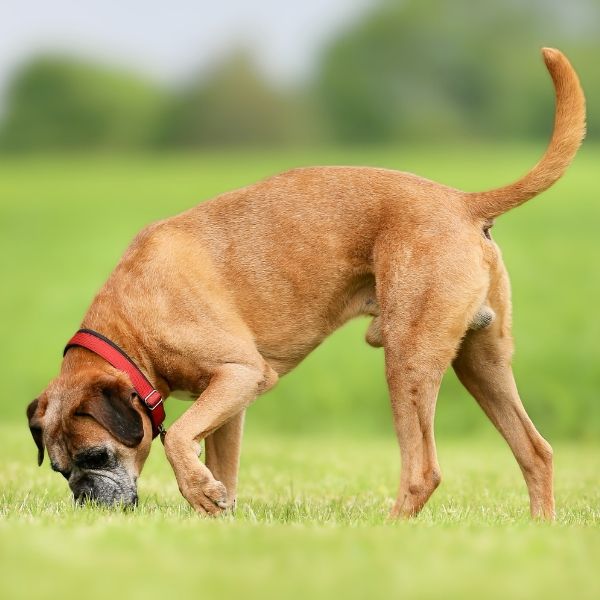 sable “plain fawn“ |  sable & white “flashy fawn“ | 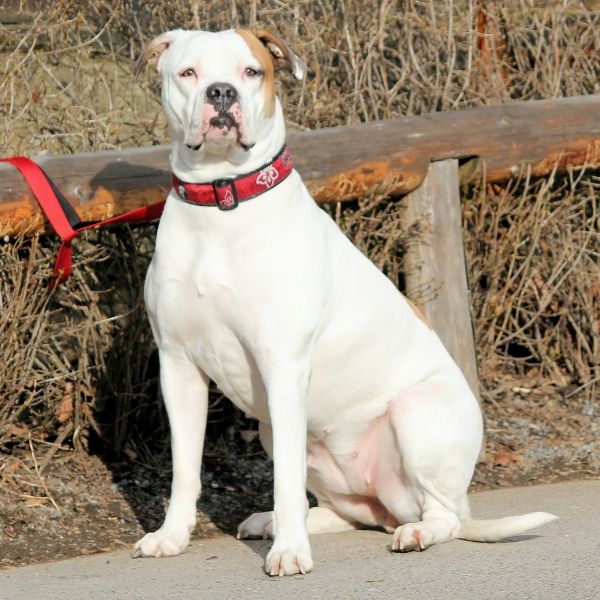 white |
| kbr/- brindle | 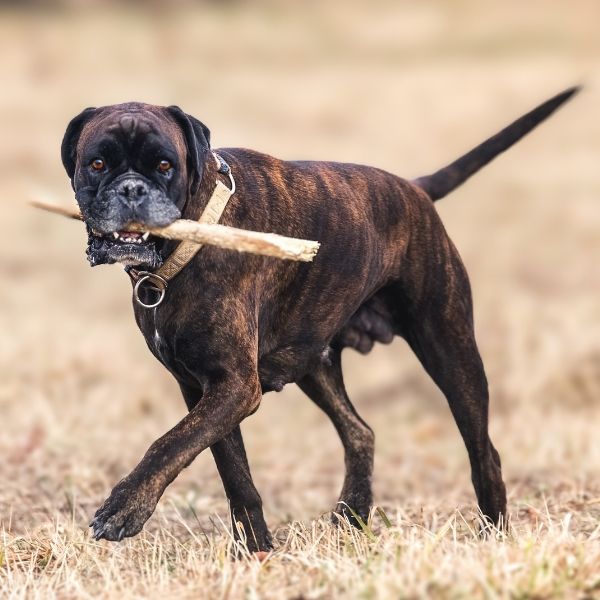 brindle “plain brindle“ | 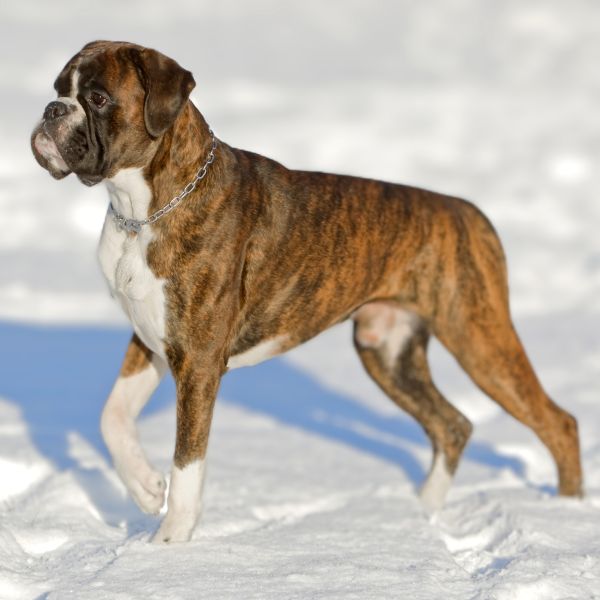 brindle & white “flashy brindle“ |  white |
Boxer Color Overview
A short discussion of breed standard patterns in the Boxer:
Fawn
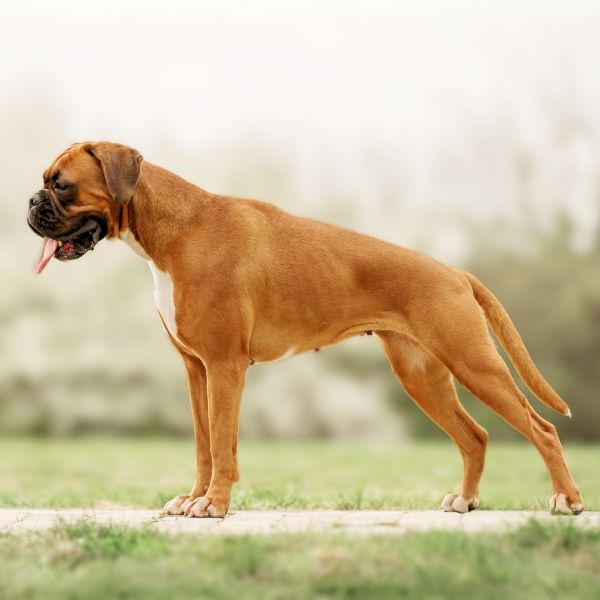
A fawn Boxer expresses a clear sable pattern (Ay/Ay) with a black mask (Em/Em) on top of his muzzle.
Fawn Boxers may come with a solid coat (S/S) or have moderate white markings (S/sP).
| E LOCUS | A LOCUS | K LOCUS | S LOCUS | |
|---|---|---|---|---|
| Plain | Em/Em | Ay/Ay | ky/ky | S/S |
| Flashy | Em/Em | Ay/Ay | ky/ky | S/sP |
Brindle
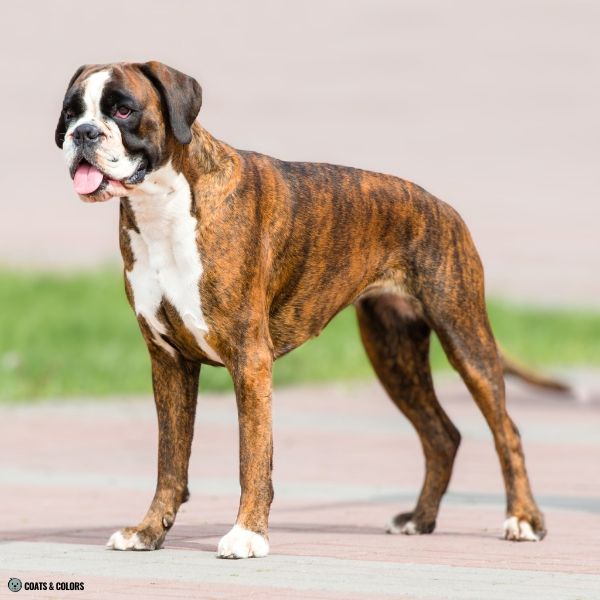
A brindle Boxer also is clear sable (Ay/Ay) with a black mask (Em/Em), just with some brindle striping (kbr/-) on top of all the red areas in his sable pattern.
Brindle Boxers may also either have no or minimal white markings (S/S) or they come with flashy white markings (S/sP) covering some of their pattern.
| E LOCUS | A LOCUS | K LOCUS | S LOCUS | |
|---|---|---|---|---|
| Plain | Em/Em | Ay/Ay | kbr/- | S/S |
| Flashy | Em/Em | Ay/Ay | kbr/- | S/sP |
Boxer Color Genetics Summary
Boxers do not have all of the alleles associated with coat colors in their gene pool.
Each breed has its own favorite patterns or colors and patterns that it considers undesirable.
Typical Boxer markings include a black mask, brindle, and flashy white spotting.
Although unwanted color patterns are selected against, they are often not completely weeded out. Sometimes, off-colors cannot be completely prevented due to common breeding practices.
Common mismarks in Boxer are solid white and solid black.
These are color traits known to occur in the Boxer breed:
| E-LOCUS | Em = melanistic mask |
| K-LOCUS | KB = dominant black (not confirmed) kbr = brindle ky = normal pattern |
| A-LOCUS | Ay = sable asa = saddle pattern (rare!) at = tan points (rare!) |
| B-LOCUS | B = black b = brown (rare!) |
| D-LOCUS | D = normal pigment |
| S-LOCUS | S = no spotting sP = piebald |
| M-LOCUS | m = non-merle |
Boxer Colors
What colors do Boxer come in?
Eumelanin
Boxers are essentially fixed for non-diluted black eumelanin (B/B D/D).
Their mask and brindle striping will be black.
Eumelanin is also visible in the nose leather, skin pigmentation, lips, eye rims, nails, or paw pads.

Phaeomelanin
The phaeomelanin comes in a range of shades from from light tan to mahogany or dark deer red. The FCI standard emphasizes that a medium red fawn coat is “most attractive“.
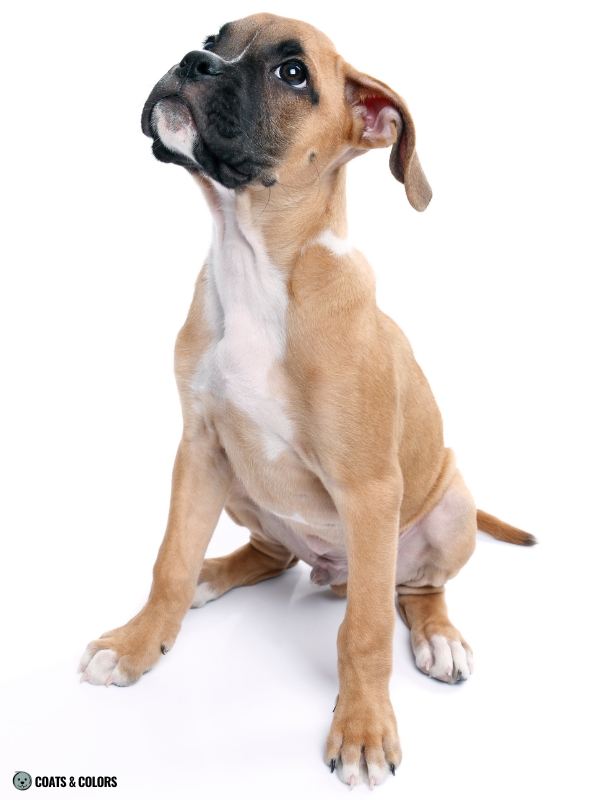
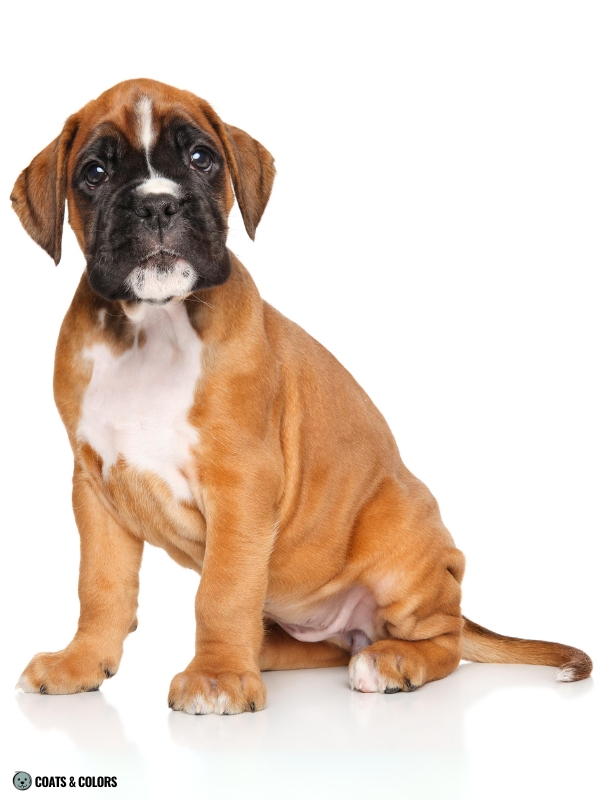
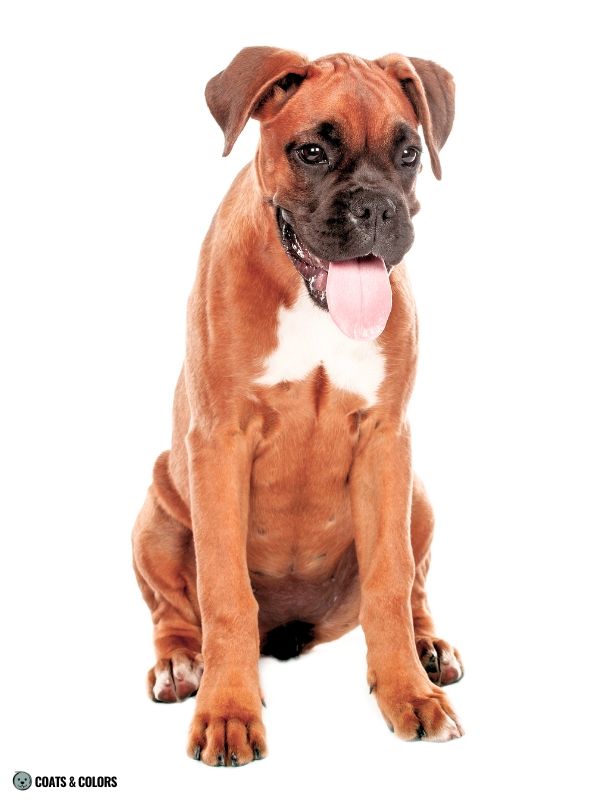
White Spotting
Boxers either have solid coats or they express piebald spotting.
Some Boxers also might have a sprinkle of whitehead. Maybe due to breeding for a nice white muzzle and blaze while at the same time keeping lots of body pigment.
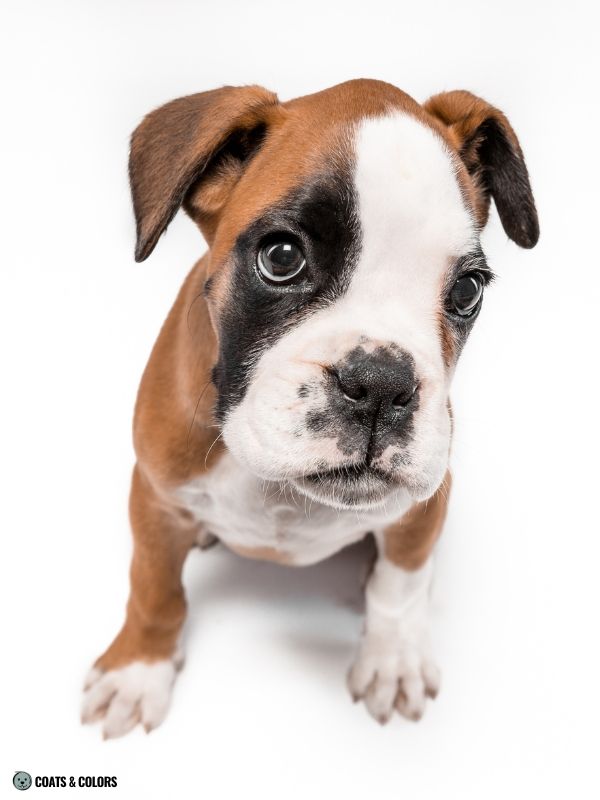
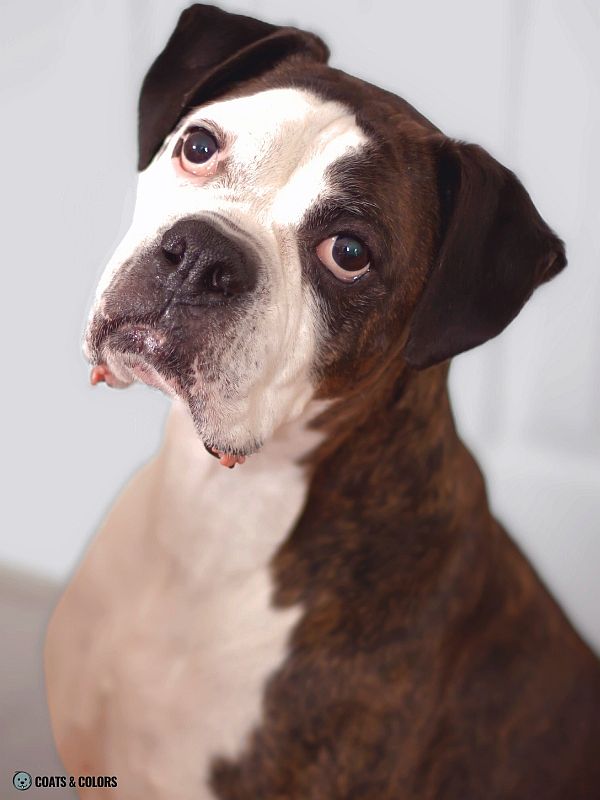
It is a matter of taste whether white markings in Boxers are to be favored. The AKC standard makes it appear that white markings are preferred, while the FCI standard reads as if they are just tolerated.
The absence of white markings, the so-called “plain” fawn or brindle, is perfectly acceptable, and should not be penalized in any consideration of color.
Boxer AKC breed standard
White markings should not be discarded. They can be quite pleasant.
Boxer FCI breed standard
In Boxers, solid patterns (S/S) are called “plain“. These dogs still might have some residual white markings from time to time, e.g. a small white chest patch.
Heterozygous dogs (S/sP) have a “flashy” pattern with a medium amount of white. The AKC defines the preferred amount of white to be one-third or less with no white on the flanks or torso.

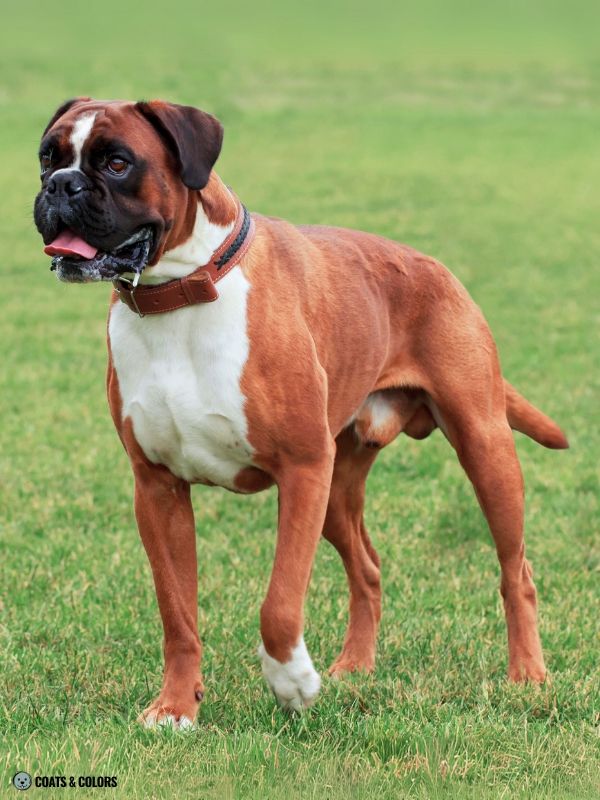
Piebald comes with untestable plus and minus modifiers that can be selected for. So the amount of white expected from piebald has to be interpreted on a breed-to-breed basis.
In the past, Boxers started selecting for a tuxedo pattern. This causes heterozygous piebald Boxers (S/sP) today to most often express a pseudo-Irish pattern with a sizeable amount of white.
Flashy markings often come with white paws and legs, a white chest and throat extending into some muzzle white, and a white blaze on the forehead, sometimes even a white collar.
But, unlike real Irish markings, piebald is never fully predictable and flashy patterns tend to cause irregular markings. In other words, two flashy Boxers rarely look the same.
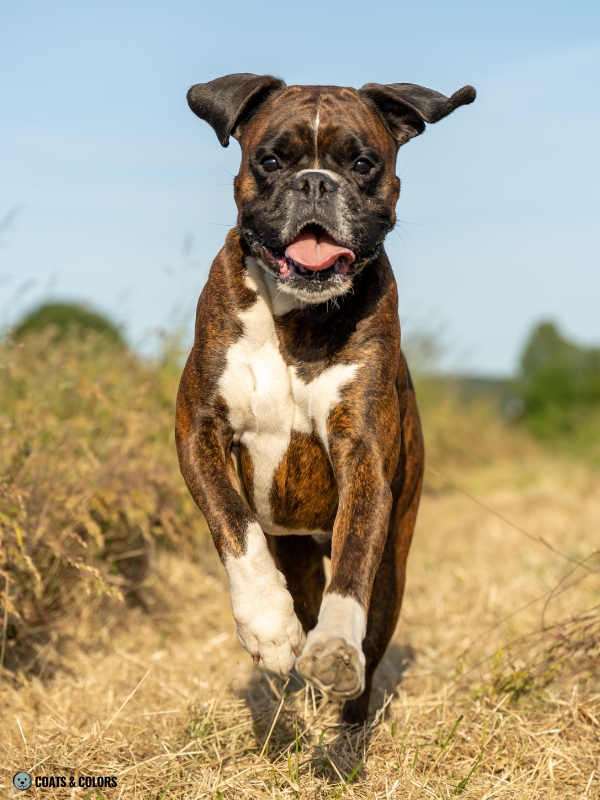
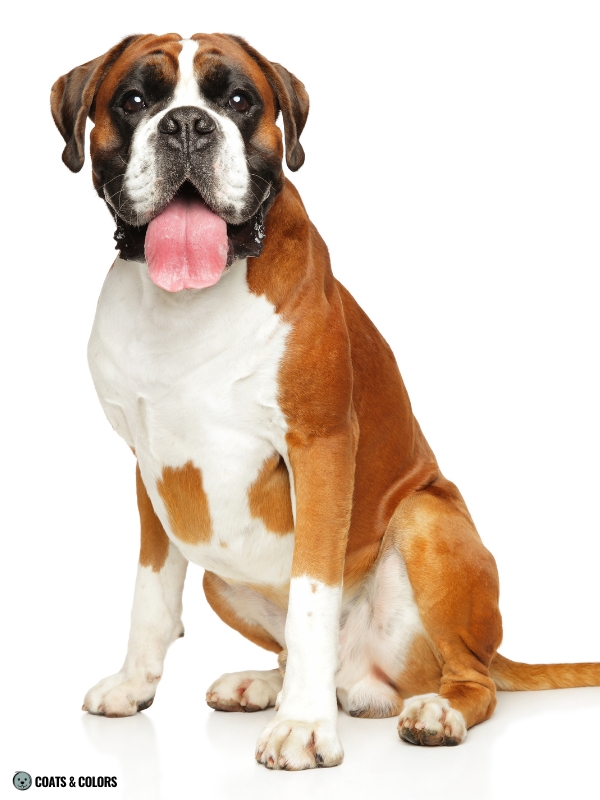

Finally, pairing two piebald carriers may result in puppies getting two copies of piebald.
In Boxers, homozygous piebald (sP/sP) more often than not causes a solid white coat. In some cases, puppies will have a piebald pattern with fawn or brindle patches on their white coat.
The breed term for white dogs with small patches of color is “check“.
All of these extended white patterns ares considered a serious mismark.

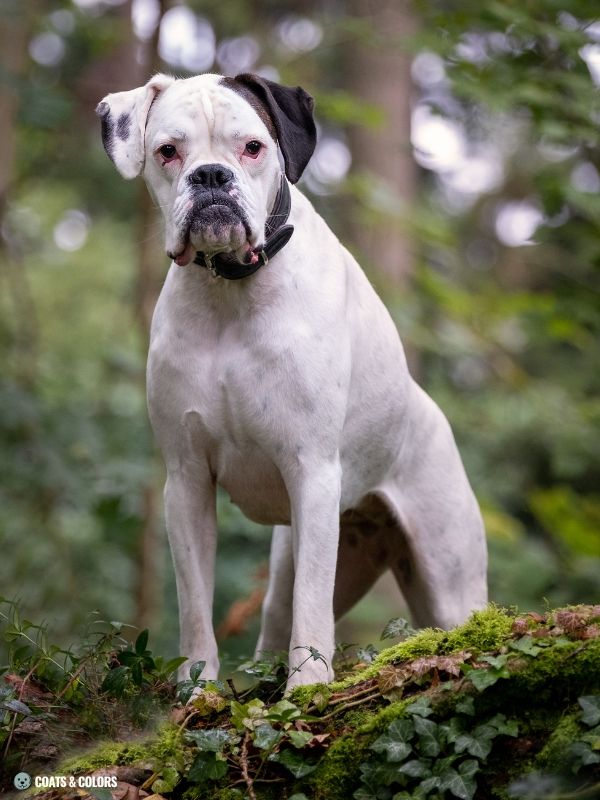
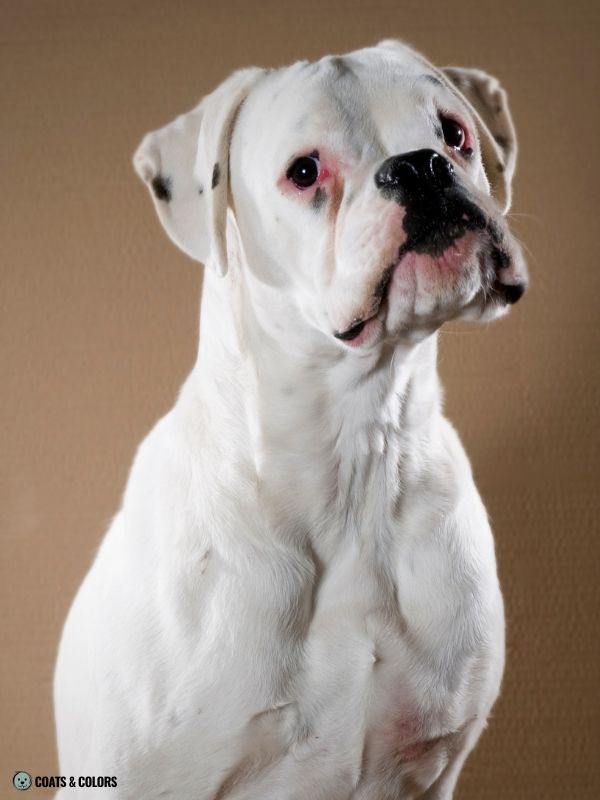
-
Em/Em-
Ay/Ay-
ky/ky-
S/S-
plain sable
-
-
S/sP-
flashy sable
-
-
sP/sP-
extended white
-
-
-
kbr/--
S/S-
plain brindle
-
-
S/sP-
flashy brindle
-
-
sP/sP-
extended white
-
-
-
-
Eye Color
Boxers produce black eumelanin. They usually have dark brown eyes.
The FCI standard mentions lighter “hawk eyes” as a fault.
It’s normal for puppies to have blueish-greenish eyes that will darken over time.
Nose Color
Boxers should have a solid black nose, black lips, and black eye rims.
The FCI standard mentions “pale nose leather” as a fault.
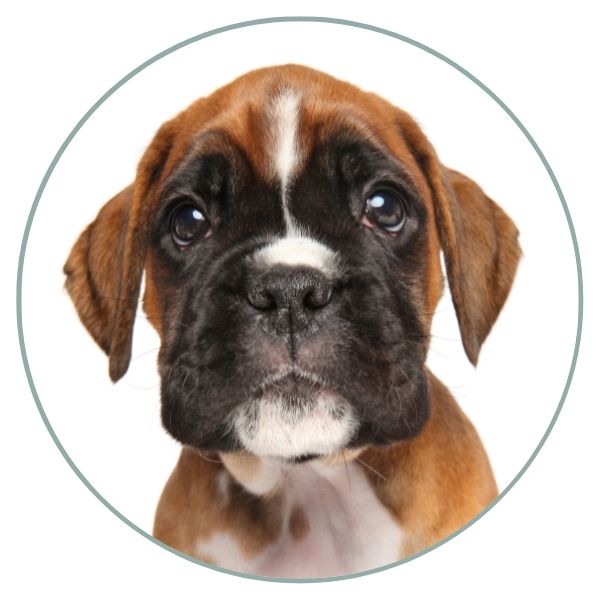

Boxer Patterns
What patterns can Boxers have?
A Locus
This breed only ever comes with a sable (Ay/Ay) pattern. The breed term for sable Boxers is fawn.
Very young puppies might still show some black shading or a black patch on their tail.
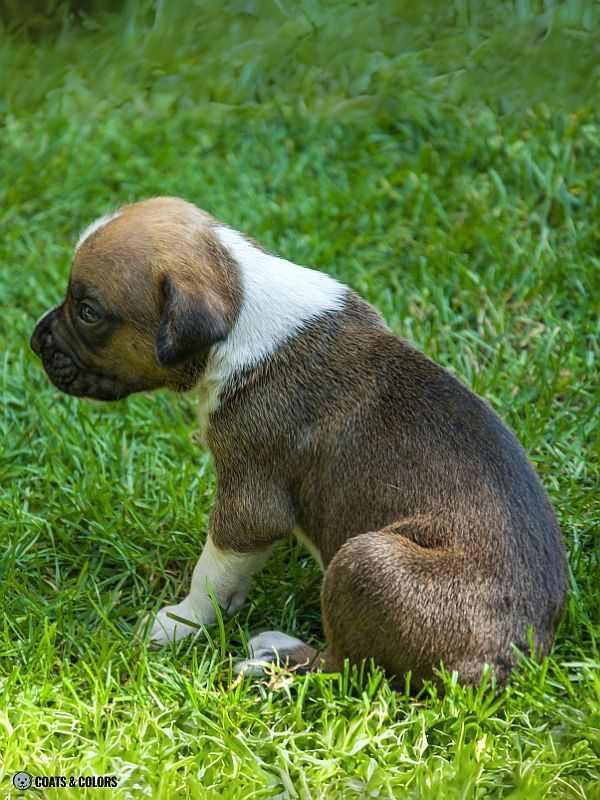

K Locus
The sable pattern in Boxers either comes with clear tan (ky/ky) or with a brindle pattern (kbr/-).
Brindle adds black stripes on top of the dog’s sable pattern.
The striping can be sparse or dense. In fact, brindle can get so dense that the dog looks almost black, when hardly anything of the fawn base coat is visible between the stripes.
Heavy black striping creates the illusion of “reverse brindle“, a black dog with fawn stripes. But this is never the case, brindle is always expressed on top of the sable pattern not the other way round!
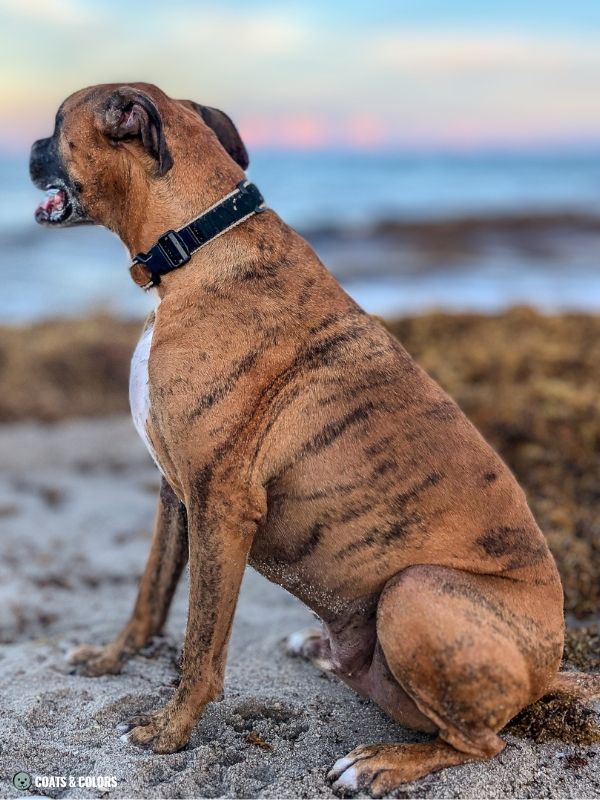
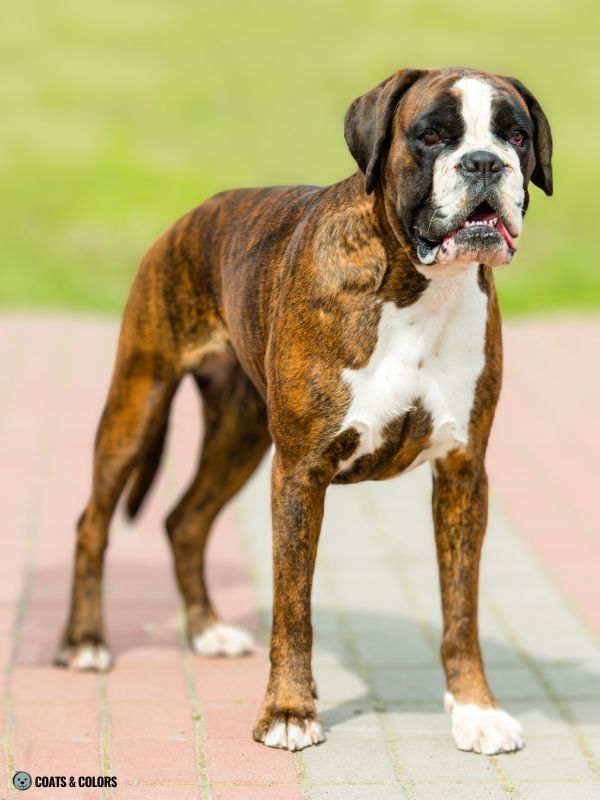
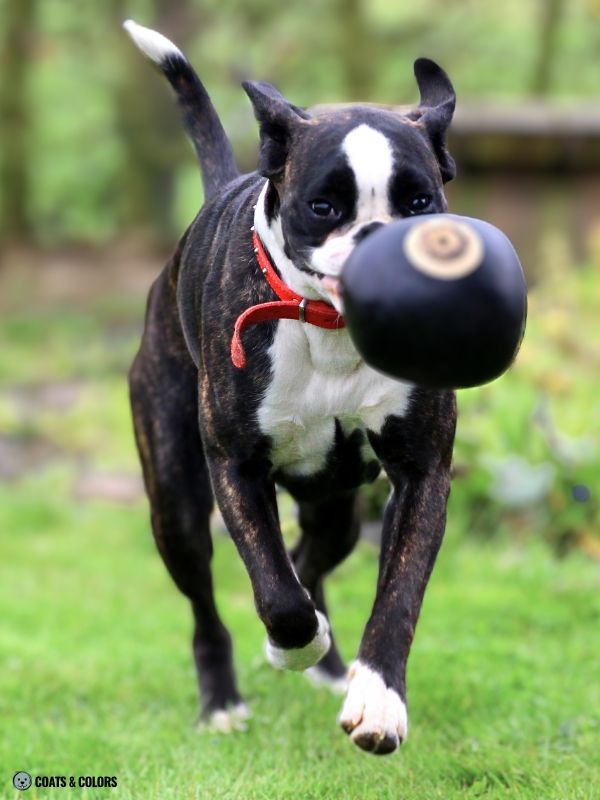
Interestingly, seal brindle seems to be a thing in Boxers and related breeds.
Seal is an untestable trait. It makes any black added by the K locus (which is where the black brindle stripes come from) a little opaque so the fawn pattern from underneath can bleed through.
In some Boxers, the striping indeed looks a little reddish-coppery instead of pitch black.
While the AKC only mentions “black stripes“, the FCI standard states that the stripes can actually be “dark or black” as long as they provide a distinct contrast to the fawn base color.
It’s a little confusing that “seal” is also used as a breed term in Boxers. They use it for solid black coats where the fawn base color got “sealed” behind a layer of black.

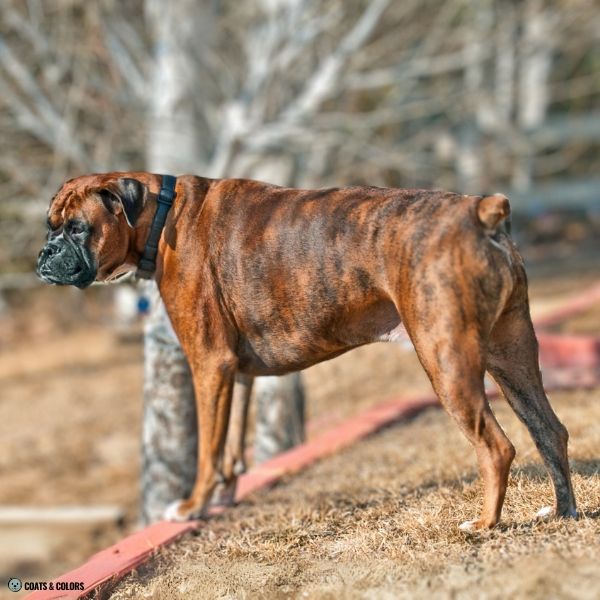
E Locus
All Boxers are fixed for a black mask (Em/Em) on top of their sable pattern.
According to the FCI standard, masks have to be “confined to the muzzle and must be in sharp contrast to the colour of the head so that the face does not appear sombre“.
Of course, the contrast is not as striking in brindled dogs.
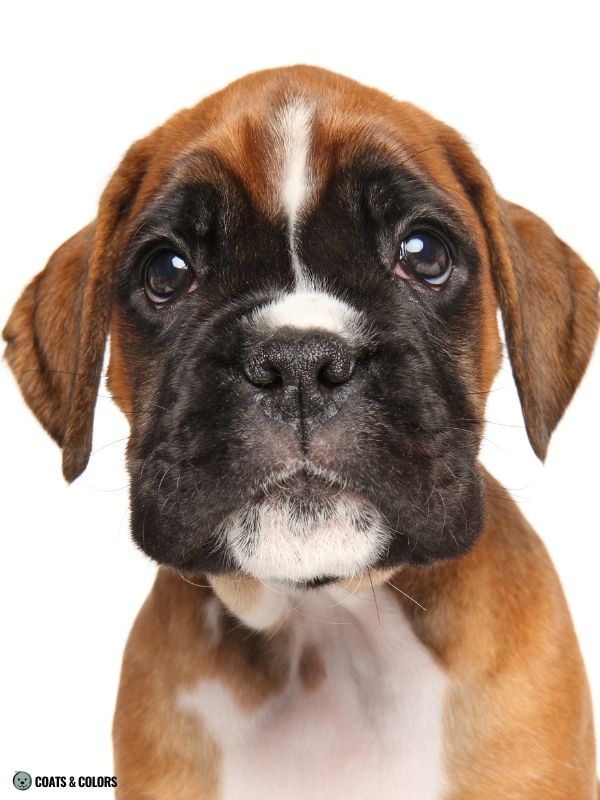
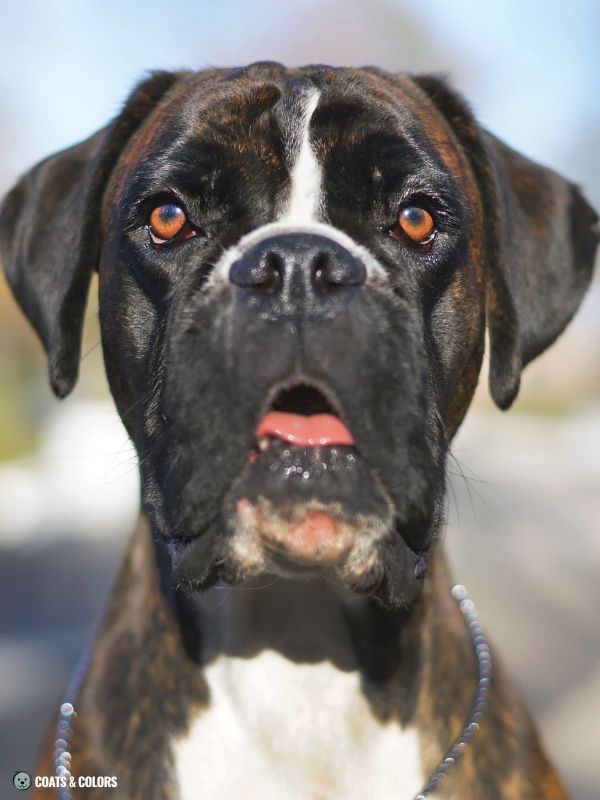
Today, very few Boxers have weak masking with only some black on their muzzle. But some Boxers express a larger than typical mask which can add black shading to a dog’s chest or underbody.
Mismarks
Recessive traits that could cause mismarks such as a tan point pattern (at) instead of sable or brown eumelanin (b) instead of black are exceptionally rare in today’s Boxer.

Em/Em kbr/- at/at S/sP
However, the most well-known mismarks in Boxers are solid black or solid white dogs.
Boxers with extended white markings (sP/sP) are the result of breeding two flashy Boxers (S/sP x S/sP).
And solid black or seal Boxers are thought to be very heavily brindled. But their color suggests they might in fact express dominant black (KB/-).
White
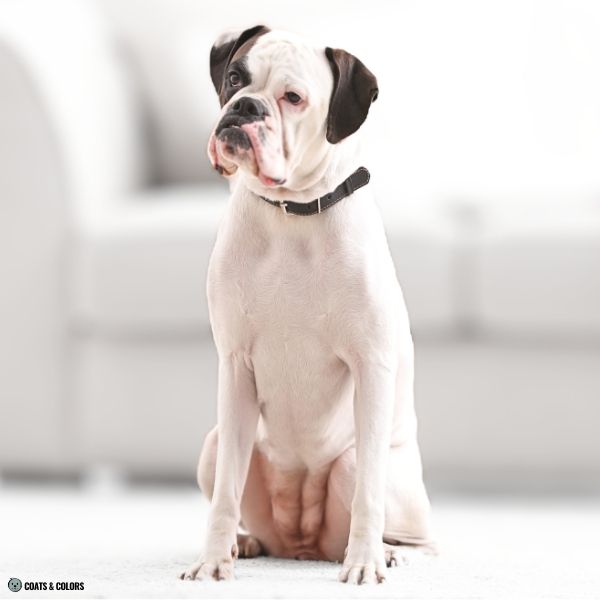
White Boxers are the result of expressing homozygous piebald (sP/sP) which causes a mostly white or solid white coat in this breed.
Extended white spotting covers most or all of the fawn or brindle pattern and may cause blue eyes and increase the risk of deafness.
Otherwise, white Boxers are normal dogs.
And they are by far not the only variety that comes with an extended lack of pigment (just think of Dalmatians, Bull Terriers, American Bulldogs, or Dogo Argentinos).
| E LOCUS | A LOCUS | K LOCUS | S LOCUS |
|---|---|---|---|
| Em/Em | Ay/Ay | ky/ky | sP/sP |
| Em/Em | Ay/Ay | kbr/- | sP/sP |
Black
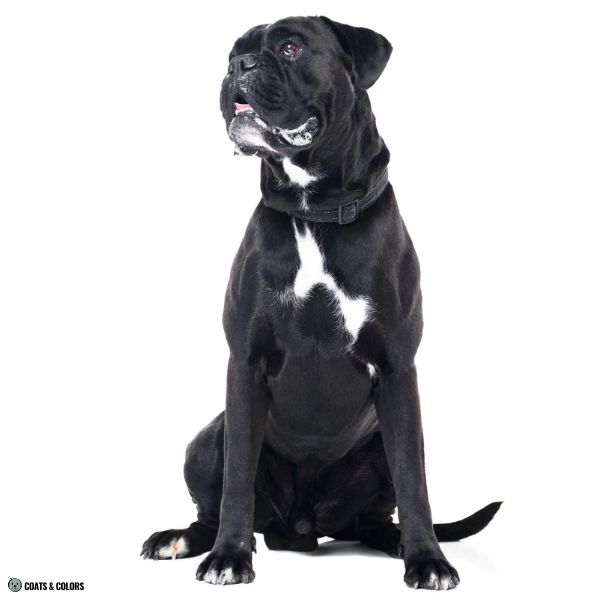
There has been a lot of speculation on what causes some Boxer puppies to be born with a black coat. Is it super heavy brindle? Is it a weird Boxer thingy? Does it come from crossbreeding?
Black Boxers are often referred to as “sealed brindle” ….hinting at an explanation where these dogs are thought to be so densely brindled that it seals the fawn coat behind the black striping.
That is because real solid black coat is considered a “genetic impossibility” in the breed.
See, in theory, there is no dominant black (KB) in Boxers. However, it is impossible to prove the presence or absence of KB in the breed by genetic testing, as brindle also tests as KB/ky.
Newer research suggests that the brindle allele (which is just KB and ky combined on the same chromosome) sometimes “falls apart”.
With this new knowledge, I’m going to go out on a limb and say that puppies from brindle parents may potentially sometimes end up with a copy of KB and a solid black coat indeed.
However, brindle (kbr) reverting back to black (KB) has not been confirmed in Boxers …yet.
But it would explain black Boxers beautifully!
| K LOCUS | |
|---|---|
| KB/- | solid black |
| kbr+/- | black brindle “reverse brindle“ |
Learn More
Links
[1] American Kennel Club (AKC): Official Standard for the Boxer (pdf)
[2] Fédération Cynologique Internationale (FCI): Boxer Breed Standard
[3] Dreger et al. (2019). True Colors: Commercially-acquired morphological genotypes reveal hidden allele variation among dog breeds, informing both trait ancestry and breed potential. PLoS ONE 14(10): e0223995. https://doi.org/10.1371/journal.pone.0223995

Hi! I’m Steffi. I am a biologist and a big time dog nerd. You are curious about coat color genetics? You’ve come to the right place! Read more.

